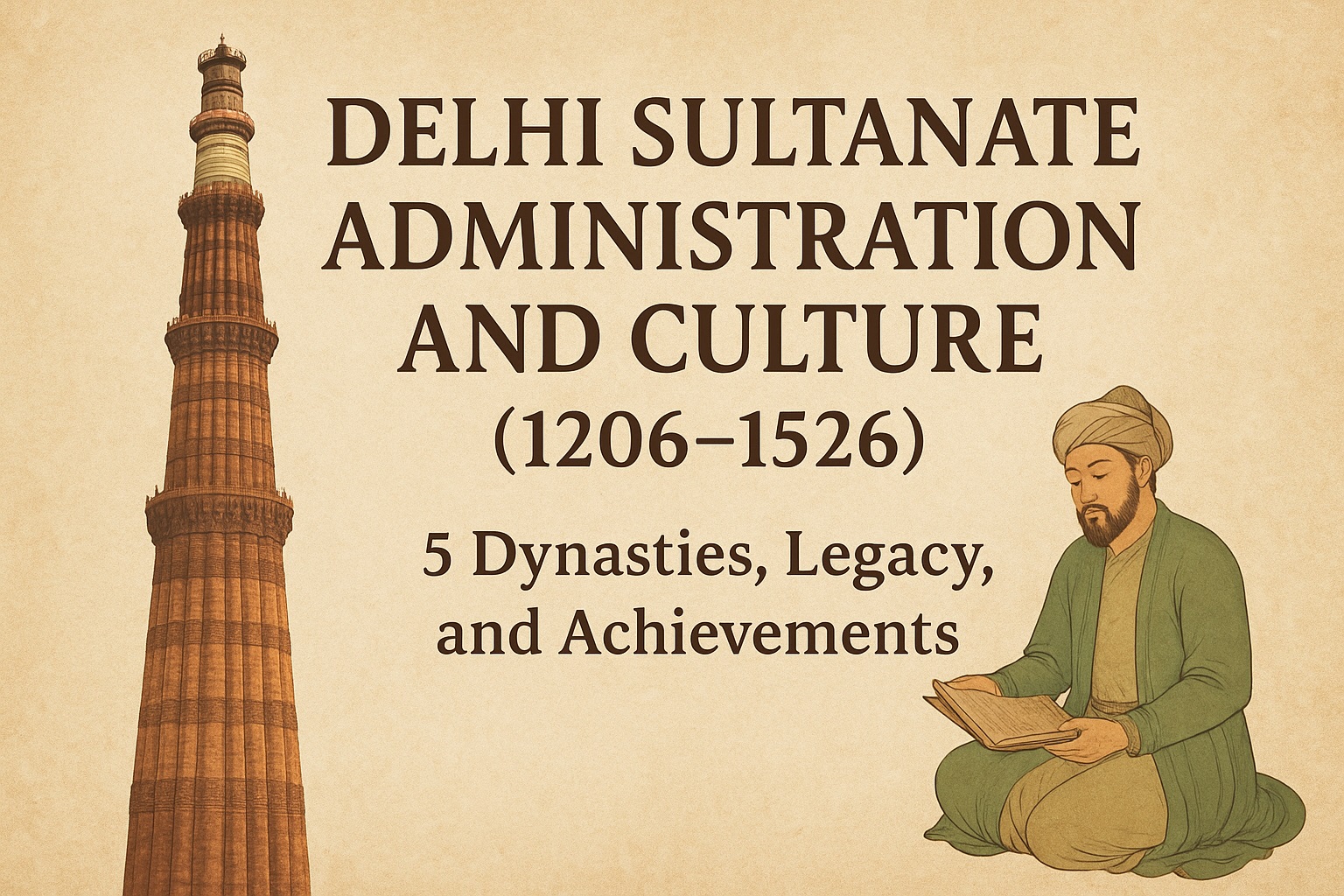Delhi Sultanate Administration and Culture-Explore 5 dynasties, iqta system, Indo-Islamic architecture, Urdu, and Sufi-Bhakti legacy.
Introduction
The Delhi Sultanate Administration and Culture (1206 CE – 1526 CE) represents one of the most transformative periods in medieval Indian history. For more than 300 years, northern India was under the rule of powerful Sultans, whose administrative system of the Delhi Sultanate, cultural policies, and military innovations reshaped the subcontinent. This era not only consolidated Muslim rule in India but also facilitated a synthesis of Persian-Islamic culture in India with indigenous traditions, giving rise to new forms of architecture, literature, and socio-religious movements.
- Related Reading: Maurya Empire and Ashoka the Great: Kalinga War, Edicts, Contributions and Legacy
- Related Reading: Golden Age of India (320–550 CE): Achievements of the Gupta Empire
Unlike earlier kingdoms, the Delhi Sultanate created a pan-Indian imperial structure with Delhi as its political nerve center. Its legacy directly influenced the Mughal Empire, which further advanced Indo-Islamic administration and culture.
Phases of the Delhi Sultanate
The Delhi Sultanate dynasties ruled for over three centuries.
Mamluk (Slave) Dynasty (1206–1290 CE)
- Founded by Qutb-ud-din Aibak.
- Built Qutub Minar, one of the finest examples of Delhi Sultanate architecture.
- Established the Iqta system of administration.
Khilji Dynasty (1290–1320 CE)
- Expansion under Alauddin Khilji into Deccan.
- Introduced economic reforms, market control, and branding of horses (military system of Delhi Sultanate).
Tughlaq Dynasty (1320–1414 CE)
- Muhammad bin Tughlaq introduced ambitious reforms: shifting capital, token currency.
- Firoz Shah Tughlaq emphasized public works, canals, and educational institutions.
Sayyid Dynasty (1414–1451 CE)-Delhi Sultanate Administration and Culture
- Limited control, mostly around Delhi.
- Rise of regional kingdoms in medieval India.
Lodi Dynasty (1451–1526 CE)
- Afghan rulers with military reforms.
- Ended with Ibrahim Lodi’s defeat at the First Battle of Panipat (1526), paving the way for the Mughal Empire.
Administration under the Delhi Sultanate
The Delhi Sultanate Administration and Culture was centralized, combining Islamic political theory with adaptations for ruling a diverse population.
Central Administration
- The Sultan – Supreme authority.
- Key officials in Delhi Sultanate administration:
- Wazir – Revenue & finance.
- Ariz-i-Mamalik – Military head.
- Qazi-ul-Quzat – Chief justice.
- Barid-i-Mumalik – Intelligence.
- Amir-i-Hajib – Court ceremonies.
– Read More: Maurya Empire – Administrative Achievements
Provincial Administration
- Empire divided into Iqtas.
- Iqtadars collected revenue and maintained law & order.
- This Iqta system in Delhi Sultanate ensured military supply and centralized control.
Military System-Delhi Sultanate Administration and Culture
- Strong standing army of Delhi Sultanate under Alauddin Khilji.
- Innovations:
- Dagh (horse branding).
- Chehra (soldier records).
Revenue Administration
- Land revenue = main income.
- Alauddin Khilji’s land reforms: surveys, fixed taxes.
- Muhammad bin Tughlaq’s revenue policies: token currency, higher taxes in Doab – mostly failed.
Culture under the Delhi Sultanate
The Delhi Sultanate was a hub of Indo-Islamic culture blending Persian, Turkish, and Indian traditions.
Religion and Society
- Islam in Delhi Sultanate was the state religion, but Hinduism flourished.
- Sufi saints (Nizamuddin Auliya) and Bhakti saints (Kabir, Namdev) spread harmony.
- Persian etiquette shaped courtly culture.
Architecture
- Blend of Islamic and Indian styles = Indo-Islamic architecture of Delhi Sultanate.
- Famous monuments:
- Qutub Minar (Mamluk).
- Alai Darwaza (Khilji).
- Tughlaqabad Fort (Tughlaq).
- Lodhi Tombs (Lodi).
– other Resource: ASI – Delhi Sultanate Monuments
Language and Literature-Delhi Sultanate Administration and Culture
- Persian – Court language.
- Urdu language under Delhi Sultanate – mix of Persian, Arabic, Turkish, and local dialects.
- Amir Khusrau enriched Delhi Sultanate literature, music, and culture.
Economy and Trade
- Flourishing Delhi Sultanate economy through trade with Central Asia, Persia, Arabia.
- Urban centers: Delhi, Multan, Bengal.
- New crops (spinach, pomegranate).
- Irrigation under Firoz Shah Tughlaq.
Legacy of the Delhi Sultanate
| Field | Contributions |
|---|---|
| Administration | Centralized authority, Iqta system |
| Military | Standing army, horse branding |
| Architecture | Qutub Minar, Indo-Islamic forts & tombs |
| Language | Persian court language, rise of Urdu |
| Culture | Sufi-Bhakti fusion, Indo-Islamic traditions |
Conclusion
The Delhi Sultanate Administration and Culture left a long-lasting impact:
- Strengthened centralized governance.
- Developed Indo-Islamic architecture.
- Promoted Persian & Urdu.
- Spread Sufi-Bhakti movements.
- Boosted trade and agriculture.
Its legacy shaped the Mughal Empire and made the Sultanate a turning point in medieval Indian history.
– Further Reading:


1 thought on “Delhi Sultanate Administration and Culture (1206–1526) – 5 Dynasties, Legacy, and Achievements”